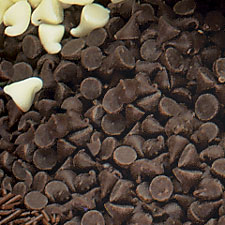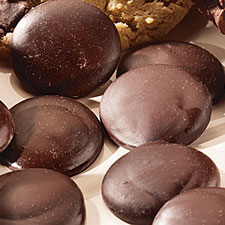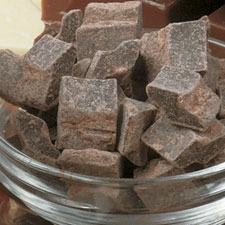Special Feature: Products Sally Recommends
Chocolate Chip Nation
 I’ve already written an article on chocolate chip cookies, but this piece is about the chocolate chips themselves. If there’s anyone who doesn’t like chocolate chips in at least one of their many forms, well, they’re not invited to my next party, that’s all I can tell you! I’m not alone in my affection for these bits of chocolate; the website www.thechocolatestore.com declares that Nestle produces around 250 million chocolate chips---on a daily basis! Chocolate chips, also called chocolate morsels, add flavor and texture to a great range of desserts, from the cookies that bear their name to mint chocolate chip ice cream. Along with nuts, they’re one of the favorite “add-ins” for brownies, cakes, and even pies (I know someone who wouldn’t think of making a pecan pie without adding chocolate chips). But there are differences in quality between brands, and there are times when it’s just not a good idea to use chocolate chips in a recipe. Let’s find out more…
I’ve already written an article on chocolate chip cookies, but this piece is about the chocolate chips themselves. If there’s anyone who doesn’t like chocolate chips in at least one of their many forms, well, they’re not invited to my next party, that’s all I can tell you! I’m not alone in my affection for these bits of chocolate; the website www.thechocolatestore.com declares that Nestle produces around 250 million chocolate chips---on a daily basis! Chocolate chips, also called chocolate morsels, add flavor and texture to a great range of desserts, from the cookies that bear their name to mint chocolate chip ice cream. Along with nuts, they’re one of the favorite “add-ins” for brownies, cakes, and even pies (I know someone who wouldn’t think of making a pecan pie without adding chocolate chips). But there are differences in quality between brands, and there are times when it’s just not a good idea to use chocolate chips in a recipe. Let’s find out more…
The first point on which I always insist is using chips or morsels that are made of real chocolate (except for white chocolate chips, which technically aren’t chocolate at all. But even then, they should be made of real white chocolate, not the cheaper and inferior “summer coating” alternative). There are chocolate-flavored chips out there, but you can forget about them; they won’t taste nearly as good. When I was a kid, further decisions were an easy matter, because there were so few of them. Chocolate chips were available in one size, one brand, and one or two flavors. But now, you have a wide range from which to choose. There are bittersweet and semisweet chips, as well as milk and white chocolate morsels. You can even find flavored chocolate chips, such as mint or raspberry (most of these chips, which contain artificial flavors, are not my cup of tea). You’ll even have to make a decision regarding size. Do you want regular-sized chips, or miniatures? Perhaps you prefer the oversized type instead?
What about chocolate chunks? In an effort to appeal to those among us who love our chocolate in larger “hits” within baked goods, some companies package chunks of chocolate. This is strictly a matter of choice if the chocolate in your recipe is an “add-in”. I actually prefer chunks to chips in some cases (in chocolate chip cookies, for example). To confuse you further, I know of several manufacturers now making small chocolate wafers. These are not chocolate cookie wafers; they’re flat, thin rounds of chocolate (often about an inch in diameter), of the type that I was taught to call pistoles (they’re also called discs). Guittard, Merckens, and Belcolade, among others, offer these discs.
Now, I’m going to get technical on you. Do you know about the “bake-stable” characteristic of some chocolate chips? If not, think about the last chocolate chip cookie you ate. It’s a safe bet that any chips in the cookie had melted during baking. But what did the cooled chips look like? If they were still in the peaked dome shape we associate with classic room-temperature chocolate chips, they didn’t flow when they were melted. Chocolate chips, chunks, etc. formulated to hold their shapes when heated are referred to as “bake-stable”. Chocolate chips that are not bake-stable are fine to use in chocolate chip cookies, too, but they’ll flow into the dough somewhat more; you’ll end up with chocolate blobs instead of peaked domes.
Chocolate chips usually contain a fairly limited number of ingredients. Therefore, there are only so many ways to adjust characteristics in chips by playing with ingredients and ingredient ratios. The best way to get your chips to be bake-stable is to reduce the amount of cocoa butter in their formulation. When these reduced cocoa butter chips melt, the melted chocolate will be thicker (or more viscous) than melted, fine-quality bar chocolate, for instance. Because it is more viscous, it won’t flow as readily, and the melted chips will hold their shapes much better. But there’s a catch (isn’t there always?). If you try to use these reduced cocoa butter chips in recipes that require fine-quality chocolate, you’ll run into trouble. Because these chips have less cocoa butter and the resulting melted chocolate is more viscous, you may have trouble incorporating the melted chocolate into your other ingredients, as it will be very thick compared to melted fine-quality chocolate. In addition, reduced cocoa butter chips won’t have the velvety smoothness or full flavor you want in your special chocolate dessert.
Does bake-stability even matter to a home baker? That depends upon the type of baker you are, I’d say. If your roster of chocolate desserts is restricted to chocolate chip cookies, brownies, and seven-layer bars, if the people who eat your chocolate desserts aren’t fussy, or if you don’t care about the shape of the chocolate bits in your cookies, then it’s not an issue. Use your favorite brand of chips or chunks. If you want to go all in, you can even buy fine-quality chocolate bars and chop them into chunks yourself. I do this often. Good-quality chocolate can make a surprising difference, even in something as humble as a chocolate chip cookie. On the other hand, if you cook or bake for a crowd of chocolate connoisseurs, or if appearances in the finished product matter to you (as they might to a caterer, for example), it’s a good idea to have some concept of what you’re buying.
In the past, chocolate chip quality was not a top priority among manufacturers. But these days, even producers of supermarket chocolate chips sometimes have upscale versions. And manufacturers of fine-quality chocolates seem to be tripping over themselves in their haste to bring you versions of their well-reputed chocolates suitable for cookie-making and other home uses. I know of at least sixteen different brands of chocolate chips, chunks, or discs designed to be used by home cooks and bakers. Not all are bake-stable, and it’s not always a simple matter to find out which fall into that category.
So what do you do? Bake-stable or non-bake-stable? Which brand of chips or chunks do you use? Before you do anything else, decide whether bake-stability matters to you. If it does, you can, if you wish, go with supermarket chocolate chips. If those don’t suit you, or you want something of higher quality, ask your seller. This is not the most commonly asked question about chocolate morsels, so your seller may not know. If they don’t, contact the manufacturer directly. If bake- stability is not an issue, I’d urge you to try as many brands with good names as your budget will allow. Just as an idea of what’s out there, you’ll find Callebaut (their chips are called “Callets”), Valrhona (they make Les Feves as well as the smaller, rounder Les Perles), Felchlin, Schokinag, Guittard (they make both cookie chips and pistoles), Cacao Barry, Merckens, Belcolade, and a number of others. I know Trader Joe’s sells chips under their own name, but they don’t make them, and they won’t tell me who does who does (although I’ve heard a rumor that it’s Callebaut). Experiment a little. Take your time and decide what you like, and remember, it’s fine to eat a few of the chip/chunks/discs by themselves. You’ll get a much better handle on their flavor, texture, and aroma that way (it’s a tough job, I know, but it’s all in the spirit of scientific inquiry!).
Miniature chips or large chunks, bittersweet or milk, bake-stable or high cocoa butter content. Like everything else, the realm of chocolate chips is an entire little world unto itself. Taking your time in exploring this world is a sweet way to broaden your chocolate horizons.
Sources and Acknowledgements:
---Jerry and Joanne, www.chocosphere.com
---Christophe, www.chocolatesource.com
---Guittard Chocolate Company, www.guittard.com
---Phil and Mary Jane, King Arthur Flour Company, www.kingarthurflour.com
---Candy Facts, www.thechocolatestore.com
Recipe of the Month:
Chocolate Chocolate Chip Pancakes
Here, a lightly chocolate batter gets an extra measure of flavor from miniature chocolate chips. I use supermarket chips for these, but better-quality chips would work at least as well. Serve with warmed apricot preserves or go all out and top these with a small scoop of good vanilla ice cream, chocolate sauce, and lightly sweetened whipped cream. I’d make these for a birthday breakfast or brunch, but they’re good any time of year.
I’ve only use nonalkalized cocoa powder to make these, but my guess is that the alkalized (Dutch process) variety would work well, too. Similarly, I have only used miniature semisweet chips here, not milk or white chips. Use a nonstick griddle to bake these. If you don’t have one, grease your griddle lightly with unsalted butter before baking each batch. Pancakes are best served immediately.
1/2 cup unbleached, all-purpose flour
3 tablespoons granulated sugar
2 tablespoons nonalkalized cocoa powder
1 teaspoon baking powder
Few grains of salt
1 egg, graded “large”
1 tablespoon tasteless vegetable oil, such as canola
About 1/3 cup milk
2/3 to 3/4 cup miniature semisweet chocolate chips
Toppings as desired
Into small bowl, sift flour, sugar, cocoa powder, baking powder, and salt. Stir until well-blended. Set aside. In another small bowl, beat egg, oil, and 1/3 cup milk with fork until well-mixed.
All at once, add liquid ingredients to dry ingredients. With fork, stir until blended, scraping sides and bottom of bowl with rubber spatula. If mixture is very thick, stir in a little more milk. You want a medium-thick batter. Stir in chips just until combined.
Hear griddle over medium-low heat until drops of cold water flicked onto it sizzle and “dance” briefly before evaporating. (If griddle is not nonstick, butter lightly with unsalted butter before baking each batch of pancakes.) Form pancakes by scooping up a generous tablespoonful of batter from the bottom of the bowl (the chips like to hide at the bottom) and dropping it onto the griddle. Don’t crowd the pancakes; I have a 12 inch square griddle and bake only four pancakes at a time, but I always bake one test pancake first, in case my heat is too high or the batter is too thick.
Bake pancakes until edges lose their “raw” glossiness and holes appear toward edges that don’t fill back in with batter. Flip over and bake on the second side until lightly browned (this will take much less time than the first side did). It can be difficult to judge the doneness of these because of the color of the batter, so be careful not to burn them.
Serve immediately with topping(s) of choice.
About 10 pancakes, roughly 3-1/2 inches in diameter each
Chocolate Recommendations of the Month:
 Usually, I recommend just one business here, but this month, I have several for you. All sell some of the higher-quality brands of chocolate morsels in their various forms and flavors. Do check around for prices, as those can differ considerably, but bear in mind that good chocolate is not cheap. To help with expenses, consider ordering a larger quantity. Chocolate morsels can go mighty quickly during holiday baking season, especially if you give food as gifts, and you’d be surprised how many you can go through. If you still don’t think you can use all of a larger package, consider splitting an order with a friend.
Usually, I recommend just one business here, but this month, I have several for you. All sell some of the higher-quality brands of chocolate morsels in their various forms and flavors. Do check around for prices, as those can differ considerably, but bear in mind that good chocolate is not cheap. To help with expenses, consider ordering a larger quantity. Chocolate morsels can go mighty quickly during holiday baking season, especially if you give food as gifts, and you’d be surprised how many you can go through. If you still don’t think you can use all of a larger package, consider splitting an order with a friend.
The first site I want to tell you about is Chocosphere, www.chocosphere.com. Jerry and Joanne offer an enormous selection of chocolates and chocolate-related products. Both are knowledgeable (especially Jerry), and they’re just plain nice folks. Here you’ll find Guittard products (Classic Cookie Chips in 9 varieties, in either 2.2 pound or 25 pound packages, as well as 7 different chocolate wafers in 3 or 4 different package sizes each); Cacao Barry pistoles in four varieties, 2.2 or 11 pounds each; Felchlin Rondos in a number of flavors in 2.2 or 4.4 pound packages (or 3 packs); an entire page of Valrhona Les Feves discs and Les Perles (click on “Valrhona for the Chef”); and about ten kinds of Callebaut Callets, in sizes ranging from 2.2 to 22 pounds.
I must not neglect to mention ChocolateSource, at www.chocolatesource.com. I have never received anything less than speedy, prompt, and polite service from this small business, and Christophe’s love for chocolate is evident in his products. Click on “Baking” to find 5 types of Callebaut Callets (in 22 pound bags only); two varieties of Schokinag chocolate pellets (also in the 22 pound size only); and six varieties of Valrhona Les Feves, in packages of 6.6 pounds each.
 Finally, there’s King Arthur Flour Baking Company, www.kingarthurflour.com. If you order by phone, you’ll almost certainly talk to someone who’s as crazy about baking as you are, which I like. The selection available includes Guittard discs, semisweet chunks, and mini chips; bittersweet pistoles from both Belcolade and Merckens; Barry Callebaut chips, chunks in two varieties, and batons (chocolate “sticks” for pain au chocolat); and Peter’s Burgundy Chunks.
Finally, there’s King Arthur Flour Baking Company, www.kingarthurflour.com. If you order by phone, you’ll almost certainly talk to someone who’s as crazy about baking as you are, which I like. The selection available includes Guittard discs, semisweet chunks, and mini chips; bittersweet pistoles from both Belcolade and Merckens; Barry Callebaut chips, chunks in two varieties, and batons (chocolate “sticks” for pain au chocolat); and Peter’s Burgundy Chunks.
![]()
Stephanie (HandOverTheChocolate@comcast.net) has had a strong affinity for chocolate from a very early age. Family members claim that, as a child, she was able to hear chocolate being opened in the kitchen no matter where she was in the house. Stephanie was baking by the time she was 6 and ran a short-lived baking business out of her parents’ kitchen when she was in high school. She has a Master’s Degree in Foods from Virginia Tech but no formal training in cooking or baking. Consequently, she is a home cook, not a chef. Prior to beginning this column, she had written about chocolate for some 8 years.
Note: This information was accurate when it was published. Please be sure to confirm all rates and details directly with the businesses in question before making your plans.



